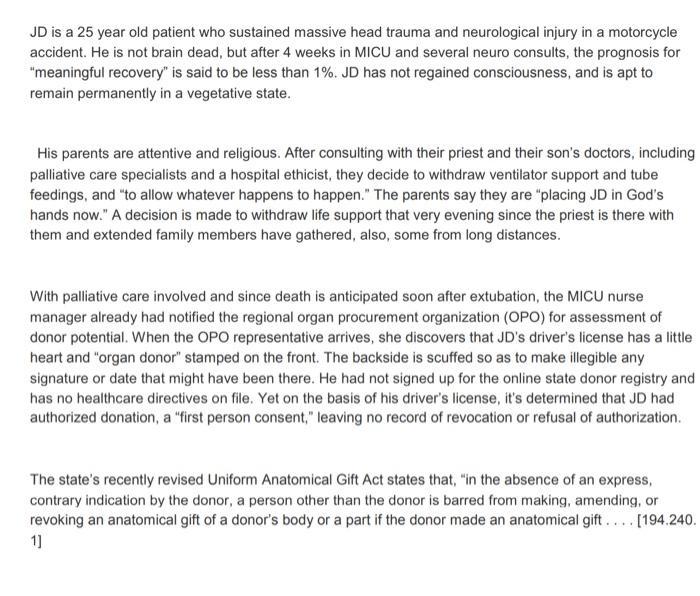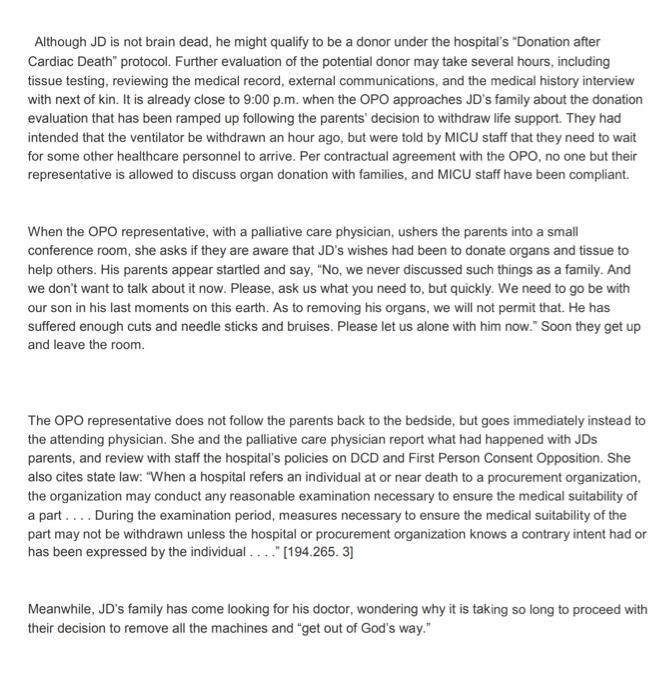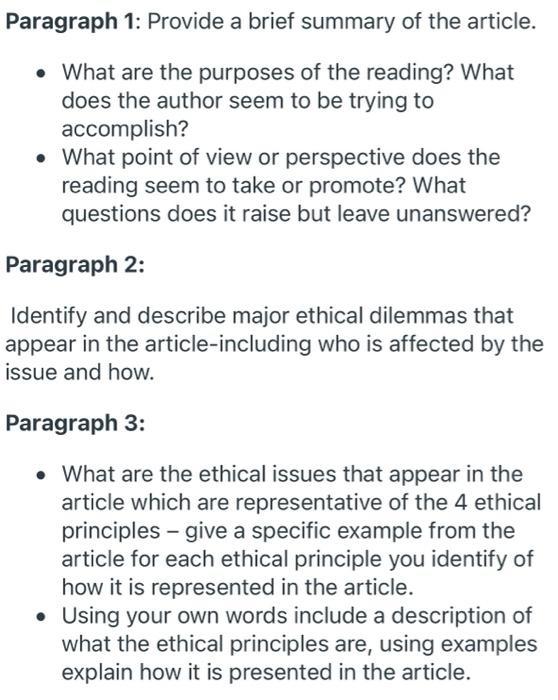Answered step by step
Verified Expert Solution
Question
1 Approved Answer
JD is a 25 year old patient who sustained massive head trauma and neurological injury in a motorcycle accident. He is not brain dead,




JD is a 25 year old patient who sustained massive head trauma and neurological injury in a motorcycle accident. He is not brain dead, but after 4 weeks in MICU and several neuro consults, the prognosis for "meaningful recovery" is said to be less than 1%. JD has not regained consciousness, and is apt to remain permanently in a vegetative state. His parents are attentive and religious. After consulting with their priest and their son's doctors, including palliative care specialists and a hospital ethicist, they decide to withdraw ventilator support and tube feedings, and "to allow whatever happens to happen." The parents say they are "placing JD in God's hands now." A decision is made to withdraw life support that very evening since the priest is there with them and extended family members have gathered, also, some from long distances. With palliative care involved and since death is anticipated soon after extubation, the MICU nurse manager already had notified the regional organ procurement organization (OPO) for assessment of donor potential. When the OPO representative arrives, she discovers that JD's driver's license has a little heart and "organ donor" stamped on the front. The backside is scuffed so as to make illegible any signature or date that might have been there. He had not signed up for the online state donor registry and has no healthcare directives on file. Yet on the basis of his driver's license, it's determined that JD had authorized donation, a "first person consent," leaving no record of revocation or refusal of authorization. The state's recently revised Uniform Anatomical Gift Act states that, "in the absence of an express, contrary indication by the donor, a person other than the donor is barred from making, amending, or revoking an anatomical gift of a donor's body or a part if the donor made an anatomical gift.... [194.240. 1] Although JD is not brain dead, he might qualify to be a donor under the hospital's "Donation after Cardiac Death" protocol. Further evaluation of the potential donor may take several hours, including tissue testing, reviewing the medical record, external communications, and the medical history interview with next of kin. It is already close to 9:00 p.m. when the OPO approaches JD's family about the donation evaluation that has been ramped up following the parents' decision to withdraw life support. They had intended that the ventilator be withdrawn an hour ago, but were told by MICU staff that they need to wait for some other healthcare personnel to arrive. Per contractual agreement with the OPO, no one but their representative is allowed to discuss organ donation with families, and MICU staff have been compliant. When the OPO representative, with a palliative care physician, ushers the parents into a small conference room, she asks if they are aware that JD's wishes had been to donate organs and tissue to help others. His parents appear startled and say, "No, we never discussed such things as a family. And we don't want to talk about it now. Please, ask us what you need to, but quickly. We need to go be with our son in his last moments on this earth. As to removing his organs, we will not permit that. He has suffered enough cuts and needle sticks and bruises. Please let us alone with him now." Soon they get up and leave the room. The OPO representative does not follow the parents back to the bedside, but goes immediately instead to the attending physician. She and the palliative care physician report what had happened with JDs parents, and review with staff the hospital's policies on DCD and First Person Consent Opposition. She also cites state law: "When a hospital refers an individual at or near death to a procurement organization, the organization may conduct any reasonable examination necessary to ensure the medical suitability of a part.... During the examination period, measures necessary to ensure the medical suitability of the part may not be withdrawn unless the hospital or procurement organization knows a contrary intent had or has been expressed by the individual...." [194.265.3] Meanwhile, JD's family has come looking for his doctor, wondering why it is taking so long to proceed with their decision to remove all the machines and "get out of God's way." Paragraph 1: Provide a brief summary of the article. What are the purposes of the reading? What does the author seem to be trying to accomplish? What point of view or perspective does the reading seem to take or promote? What questions does it raise but leave unanswered? Paragraph 2: Identify and describe major ethical dilemmas that appear in the article-including who is affected by the issue and how. Paragraph 3: . What are the ethical issues that appear in the article which are representative of the 4 ethical principles - give a specific example from the article for each ethical principle you identify of how it is represented in the article. Using your own words include a description of what the ethical principles are, using examples explain how it is presented in the article. Paragraph 4: Is the reading relatively clear or unclear, deep or superficial, strong or weak, insightful and complex or simple and biased? How is the reading similar to other sources of information that you are familiar with (written, filmed, televised, etc.)? Especially important as the semester progresses: how does the reading relate to others that we have studied in our course? How does the reading relate to your own life experiences, ideas, values, etc.? What is your judgment or evaluation of this reading-and, importantly, what are the criteria on which you base this judgment or evaluation? Is your judgment based primarily on rational or emotional responses? Would your judgment differ if you were to switch modes (from emotional to rational)? Your submission should be concise and free of spelling and grammatical error, before it is submitted. Case Study Analysis is due on or before the due date.
Step by Step Solution
★★★★★
3.58 Rating (165 Votes )
There are 3 Steps involved in it
Step: 1
Paragraph 1 This case revolves around the ethical complexities of organ donation in a situation where a patient JD is facing withdrawal of life suppor...
Get Instant Access to Expert-Tailored Solutions
See step-by-step solutions with expert insights and AI powered tools for academic success
Step: 2

Step: 3

Ace Your Homework with AI
Get the answers you need in no time with our AI-driven, step-by-step assistance
Get Started


